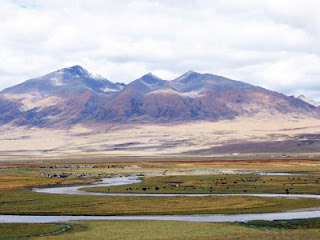The Marathon Monks of Mt. Hiei

Straw Sandals
Among the many evocative black-and-white photographs that grace this wonderfully strange, if not entirely satisfying, book is the image of a row of straw sandals, hanging illuminated in the darkness. They look unpromising as protection for the feet, less like shoes than elongated birds' nests held together by bits of string. Yet these are the sandals worn by the gyoja, the so-called "marathon monks" of Japan, as they run the rocky and frequently rain-slicked paths on the five peaks that make up the mountain complex of Mt. Hiei.
One pair of sandals suffices, under ideal conditions, for perhaps a single day of running. Conditions are frequently not ideal in this part of Japan. And the gyoja will run far more than a single day at a stretch.
In heavy rain, the straw sandals disintegrate in a matter of hours. So something seems seriously amiss with the figure of 80 pairs of sandals that Stevens tells us is allotted to each monk per 100-day "marathon"--an ordeal that entails running up to 52 miles a day, every day, without a break for the entire 100-day cycle. Leaving aside every other aspect of running so mind-bogglingly far, the battering their feet must endure is difficult to imagine.
1000 days of running
Although Stevens does not dwell on the details (he has little to say about the actual experiences of the gyoja while running) similar hardships surely abound for the gyoja. They run through the night on mountain trails without illumination, except what the stars and moon might provide. They scitter along on their flimsy straw sandals across sharp rocks and nests of leaves that may or may not contain vipers, making innumerable mandatory stops at shrines and other stations whose location must be memorized. It makes a modern, organized, supported 100-mile ultra look cushy.
Before each 100-day cycle of running, the gyoja observe a period of preparatory maegyo, which involves a careful settling of one's affairs and a severe restriction of diet. For members of one sect, this means subsisting on a diet of nuts, buckwheat paste, potatoes, and pine needles. Food intake during the 100-day run is hardly more robust, apparently amounting to fewer than 2000 calories a day.
Like the 80 pairs of straw sandals, there is something screwy with this figure. It seems wholly inadequate for the effort of running 50 miles a day for 100 days. It seems scarcely adequate for 100 days of lying around at home on the sofa.
Ten 100-day cycles completed over a period of 7 years make up the sennishi kaihogyo, the grand 1000-day cycle of running. Each year ups the ante, with the longest sustained runs occuring in the 6th and 7th years. Yet the 5th year ends with what to me seems the most harrowing and terrifying test of all.
"The heart of emptiness is not forgotten"
The doiri, or "entry to the hallway," is not a run. In doiri, completed at the end of the 5th year in the 7-year cycle of sennichi kaiyogo, the monk endures 9 days without food, without water, without sleep. During this time, he must remain standing, keeping his head erect. It is symbolically, and sometimes literally, an encounter with death (apparently the doiri was originally 10 days, but too many monks died). Those who pass through this ordeal emerge as something new, living Buddhas.
In several centuries worth of sennishi kaihogyo, scarcely more than a few handfuls of monks have completed the entire 1000-day 7-year cycle. The monk Saicho, whose image appears on the cover of the book, has completed it twice. More remarkably, his training as a gyoja did not begin until the atypcially advanced age of 40. Saicho's unusual life story, from unpromising youth and troubled adulthood to mid-life conversion, is told in this book, along with accounts of other well-known gyoja.
Stories of individual monks like Saicho are the most engaging sections of Stevens' book. When it comes to the inner experience and sensory impressions of the runs themselves, however, he has little to say. So what was it like? He doesn't appear to have asked the question. Stevens speaks only of externals--sandals and hats, mileage and calorie counts. Calmly or blandly, depending on your perspective, he reports the bare facts of this most unusual chapter in the history of human consciousness.
Perhaps the lack of affect is deliberate, yet I had moments of sympathy with the Goodreads poster who commented that, despite the inherent fascination of the topic, The Marathon Monks of Mt. Hiei "read like a field guide to fungus."
Taken on its own merits, though, the book is rewarding, and there appears to be nothing else on the subject quite like it. The first half is devoted to a brief history of Tendai Buddhism and the development of the monastery on Mt. Hiei. This structure mirrors the preparation of the gyoja: before they are permitted to undertake the sennichi kaihogyo, monks must undertake years of study and meditation. They learn calmness, how to "stop the waves of confused thinking from churning"; the goal is to perceive the emptiness of the world, but not be separated from connnection with others, to be "engaged in a thousand affairs yet not be ruled by emotion beause the heart of emptiness is not forgotten."
This sounds like an effective mental state for running immense distances, or just navigating an average day in the modern world.
You might also like
Lung-gom-pa runners of old Tibet



Comments
Post a Comment